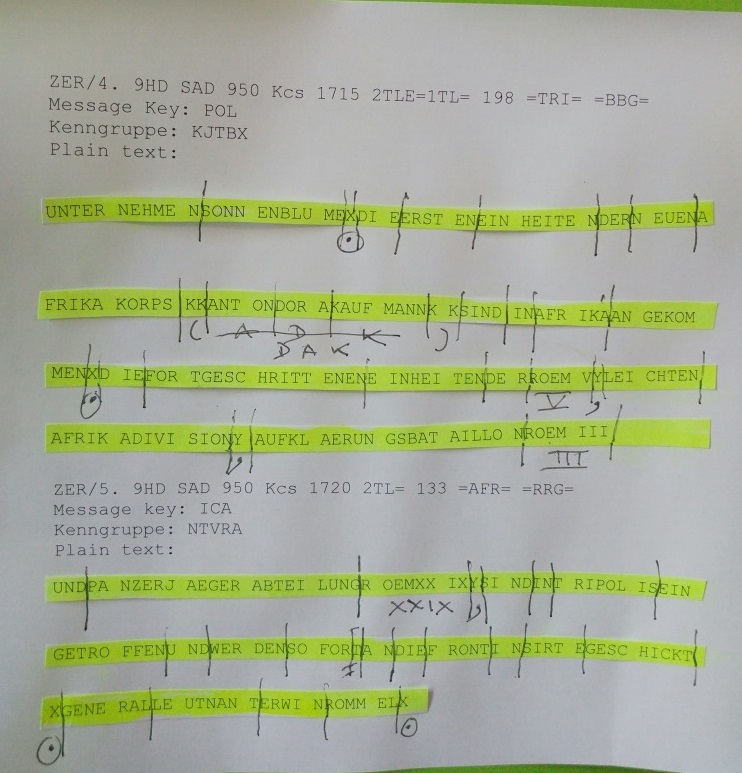Hut 3: Translation and interpretation of messages
Introduction
At BP, the Hut 3 was in charge to extract Intelligence about Enigma messages which came from Army and Air Force.
At the beginning of 1940, the Hut 3 only deal with translating the messages and transmitting them to Whitehall. It was comprised of only three people, led by Lt. Commander Malcom Saunders. Later, it would become a key part of the allied intelligence system by interpreting the messages and information associated with radio interceptions and delivering them directly to the HQ, who needed them. The Hut 3 never exceeded 150 persons.
A Duty Officer was in charge of the Hut when the head of the Hut was not on the spot. There was always one Duty Officer at a time round the clock.
Hut 3 was made up of several sections: the watch, the section 3M for army intelligence, the section 3A for air force intelligence, a small signals intelligence section and a small group working on the less urgent intelligence problems.
The Watch
The Watch was the most important section of Hut 3. It first of its function was the translation of the german messages which came from Hut 6. These messages corresponded to the decryption of the Enigma cryptograms. They were in five-letter groups. Before carrying out the translation, the members of the Watch had to reconstruct the german text by indicating the separation of words, adding punctuation and replacing abbreviations. They also had to interpret corrupt texts.
A member of the Watch handed to his chief the Hut 6 raw deciphering text (by 5 letters groups) plus his own English translation. The head of the Watch checked the translation and pass the message to the 3M or 3A section (just a table near by).
The head of the Watch had to decide what was more urgent. Sometimes old intelligence from an active front could be more useful than recent messages.
The Watch was in permanent session from the sping of 1940. A watch worked for eight hours.
The 3A section
The 3A consisted of its head, his deputy and their secretary, the Air Advisers and the Air index.
The Air advisers worked in shifts, in pairs, in the Watch. They saw everything that passed through the Watch. They decide if a particular piece of information should be signaled to a command. Secondly they had to decide which commands should have it, and, how fast. There was one immutable rule. Everything signaled to a particular command had to be repeated to that command’s superior HQs.
In brief: every translated texts was transmitted to London – to the HQ of the SIS in Broadway. And to the intelligence staffs at the three service ministries. The most important message went by teleprinter. Hut 3 also communicated directly with operational commands. The corresponding intelligence officers in the field briefed the Commander-in-Chief.
Until 1941, the generals who received information from Hut 3 did not know where it came from.
The Air index was the central repository of watch Ultra knew about the Lufwaffe. It consisted of about two dozen girls and hundreds of thousands of cards. Every individual mentioned in Ultra had a card, every unit, every place. There were cards for pieces of equipment, cover names,… The head of the shift of indexers received a copy of every message that passed through the Watch. On it she marked in red chalk each word and phrase to be indexed.
Example of translation
The raw materials
ZER/4. 9HD SAD 950 Kcs 1715 2TLE=1TL= 198 =TRI= =BBG= Message Key: POL Kenngruppe: KJTBX Plain text: UNTER NEHME NSONN ENBLU MEXDI EERST ENEIN HEITE NDERN EUENA FRIKA KORPS KKANT ONDOR AKAUF MANNK KSIND INAFR IKAAN GEKOM MENXD IEFOR TGESC HRITT ENENE INHEI TENDE RROEM VYLEI CHTEN AFRIK ADIVI SIONY AUFKL AERUN GSBAT AILLO NROEM III ZER/5. 9HD SAD 950 Kcs 1720 2TL= 133 =AFR= =RRG= Message key: ICA Kenngruppe: NTVRA Plain text: UNDPA NZERJ AEGER ABTEI LUNGR OEMXX IXYSI NDINT RIPOL ISEIN GETRO FFENU NDWER DENSO FORTA NDIEF RONTI NSIRT EGESC HICKT XGENE RALLE UTNAN TERWI NROMM ELX
Recomposition of the text (with word separation, ...)
Decipherments from Type-X are in the form of strips of paper (like telegrams) glued to a sheet of paper. The text is made up of groups of five letters. The Hut 3 officer delimits words and interprets punctuations and abbreviations.

2. 9HD SAD (Tripoli to Berlin) 950 Kcs 1715 2TLE Unternehmen Sonnenblume. Die ersten Einheiten der neuen Afrikakorps (DAK) sind in Afrika angekommen. Die fortgeschrittenen Einheiten der 5. leichten AfrikaDivision, Aufklaerungsbataillon 3. und Panzerjaegerabteilung 39., sind in Tripolis eingetroffen und werden sofort an die Front in Sirte geschickt. Generalleutnant Erwin Rommel.
Translation
Sunflower operation. The first units of the new Africa Corps (DAK) have arrived in Africa. The advanced units of the 5th Africa Light Division, 3rd Reconnaissance Battalion and 39th Panzerjaeger Division have arrived in Tripoli and are immediately sent to the front at Sirte. Lieutenant General Erwin Rommel.Example of Abbreviations interpretation (a genuine one)
1. - VPT 0102 2 Tle An L.G.K.XI. Delmenhorst nahm am 27.X. 4 Sprueche auf und zwar:0735, 1050,2011 und 2145. Mirgehoert wurden 12 Sprueche. LN.Kp.Delmenhorst.Translation : To Luftgaukommando XI. Delmenhorst on October 27 recorded 4 messages: 0735, 1050, 2011 and 2145. 12 messages were received. Luftnachrichten-Kompanie. Delmenhorst.
Remarks:
- Delmenhorst is a city in lower Saxony, Germany.
- L.G.K or LG.Kdo. are the abbreviation of Luftgaukommando.
- LN. Kp is undoubtedly the abbreviation of Luftnachrichten-Kompanie (i.e. a listening service; signal intelligence).
- 27.X corresponds to October 27.